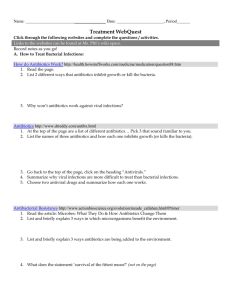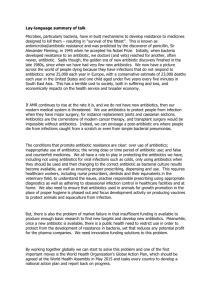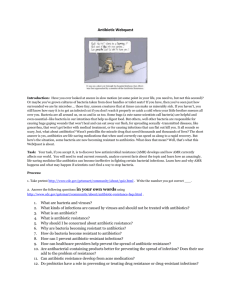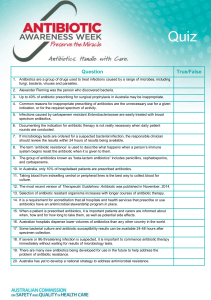file - The Bella Moss Foundation
advertisement
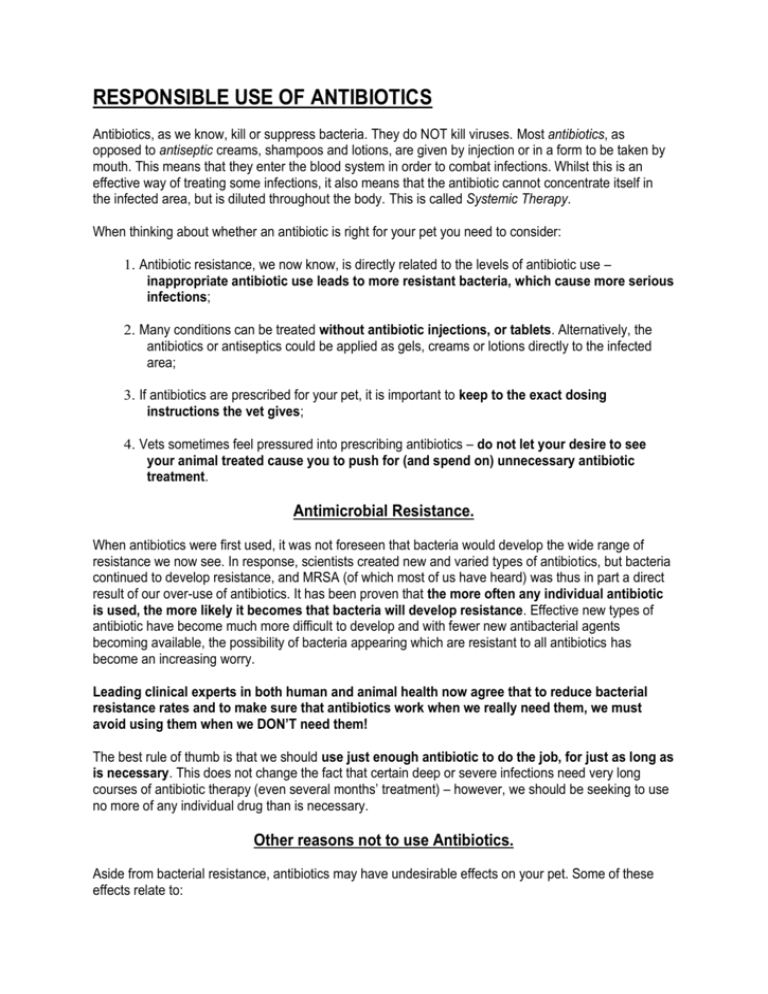
RESPONSIBLE USE OF ANTIBIOTICS Antibiotics, as we know, kill or suppress bacteria. They do NOT kill viruses. Most antibiotics, as opposed to antiseptic creams, shampoos and lotions, are given by injection or in a form to be taken by mouth. This means that they enter the blood system in order to combat infections. Whilst this is an effective way of treating some infections, it also means that the antibiotic cannot concentrate itself in the infected area, but is diluted throughout the body. This is called Systemic Therapy. When thinking about whether an antibiotic is right for your pet you need to consider: 1. Antibiotic resistance, we now know, is directly related to the levels of antibiotic use – inappropriate antibiotic use leads to more resistant bacteria, which cause more serious infections; 2. Many conditions can be treated without antibiotic injections, or tablets. Alternatively, the antibiotics or antiseptics could be applied as gels, creams or lotions directly to the infected area; 3. If antibiotics are prescribed for your pet, it is important to keep to the exact dosing instructions the vet gives; 4. Vets sometimes feel pressured into prescribing antibiotics – do not let your desire to see your animal treated cause you to push for (and spend on) unnecessary antibiotic treatment. Antimicrobial Resistance. When antibiotics were first used, it was not foreseen that bacteria would develop the wide range of resistance we now see. In response, scientists created new and varied types of antibiotics, but bacteria continued to develop resistance, and MRSA (of which most of us have heard) was thus in part a direct result of our over-use of antibiotics. It has been proven that the more often any individual antibiotic is used, the more likely it becomes that bacteria will develop resistance. Effective new types of antibiotic have become much more difficult to develop and with fewer new antibacterial agents becoming available, the possibility of bacteria appearing which are resistant to all antibiotics has become an increasing worry. Leading clinical experts in both human and animal health now agree that to reduce bacterial resistance rates and to make sure that antibiotics work when we really need them, we must avoid using them when we DON’T need them! The best rule of thumb is that we should use just enough antibiotic to do the job, for just as long as is necessary. This does not change the fact that certain deep or severe infections need very long courses of antibiotic therapy (even several months’ treatment) – however, we should be seeking to use no more of any individual drug than is necessary. Other reasons not to use Antibiotics. Aside from bacterial resistance, antibiotics may have undesirable effects on your pet. Some of these effects relate to: 1. Commensal bacteria These are beneficial bacteria that normally live on all animals. They generally cause no problem and even make it more difficult for other bacteria to flourish and cause problems. Antibiotics may kill these ‘helpful’ organisms and therefore allow them to be replaced by other, more harmful bacteria. 2. Hypersensitivity Hypersensitivity occurs when a pet’s immune system over-reacts to even tiny amounts of a drug and causes an allergic reaction. This can be life-threatening as people who are allergic to penicillin well know. 3. Direct drug toxicity To be effective against some bacteria, some kinds of antibiotics need to be used at doses which can cause damage to tissues and make the treated animal feel ill, e.g. the class of antibiotics known as aminoglycosides can cause ear damage; 4. Breed specific problems. Doberman Pinschers may be particularly likely to react badly to the sulphonamide group of antibiotics. Although these problems are not common, we need to know, before giving an animal an antibiotic, that the risks are worth taking – again, that means knowing that the antibiotic is absolutely necessary. When are Antibiotics Needed? In general there are only three times when antibiotic use is necessary: 1) When definite bacterial infection is present and will not respond to other treatment 2) Where infection may not be present but is highly likely to develop This is particularly where a patient has an impaired immune system 3) Where an infection could lead to total catastrophe It is often the case that antibiotics are required when a surgical procedure (such as orthopaedic surgery) is likely to be prolonged and the risk of infection is significantly increased. So, before choosing to use an antibiotic, your vet will ensure that one of the above circumstances applies and choose an antibiotic likely to be effective. Clinical judgement can often be made about which bacteria are most likely to be present in a given situation, but it is also recommended that testing is done where possible to identify the specific bacterium and the medicine that will be most effective against it. A large number of problems do NOT need antibiotic treatment in the first instance. These include: Simple diarrhoea This is most frequently down to dietary indiscretion in dogs (eating something unusual, and is often best managed by changes to feeding and basic husbandry Viral diseases Antibiotics are not useful against viruses; for example, colds do not require antibiotics. The exception is where a viral infection allows a bacterial infection to take over (“secondary infection”), for example in cats with herpesvirus. Allergic skin itches Unless the skin is showing specific signs of bacterial infection, antibiotics are usually unnecessary. In addition, there are certain bacterial infections that can be controlled using methods other than antibiotics (e.g. very mild skin infections), or that can be controlled by delivering antibiotics only to the infected area of the body (such as drops for eye or ear infections). Again, this allows us to minimise the use of the antibiotic, and therefore the chances of either side effects or bacterial resistance. Giving Antibiotics to your Pet. Each time an antibiotic is given, there will be specific dosing instructions – Your vet will choose an appropriate medication, dose, frequency and length of treatment for your pet’s condition It is extremely important to follow the instructions. The dose and frequency are chosen to maximise the effectiveness of the antibiotic. Certain infections can be very difficult to stop and dangerous bacteria may survive at low levels even though your pet appears normal. In such cases, if the antibiotic treatment is stopped prematurely, the remaining bacteria can breed and cause problems, and may get a chance to develop resistance to the antibiotic used. Bella Moss Foundation 2011



